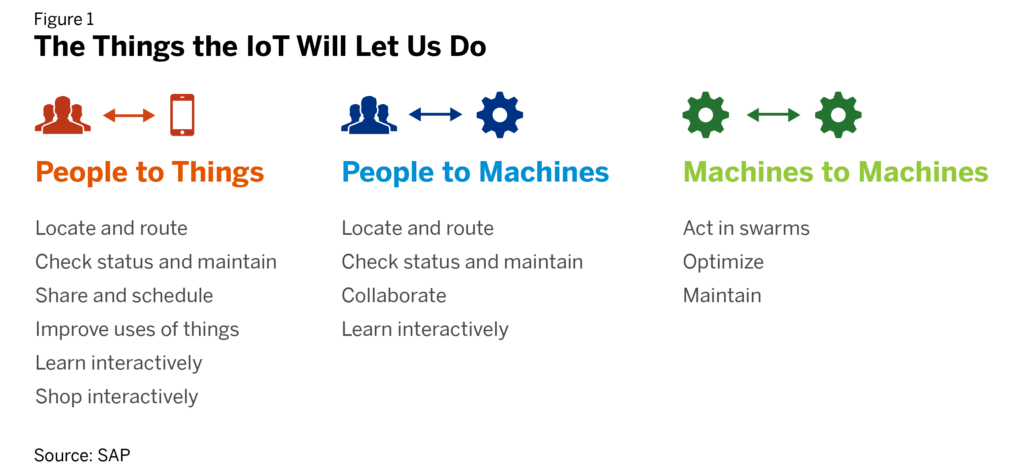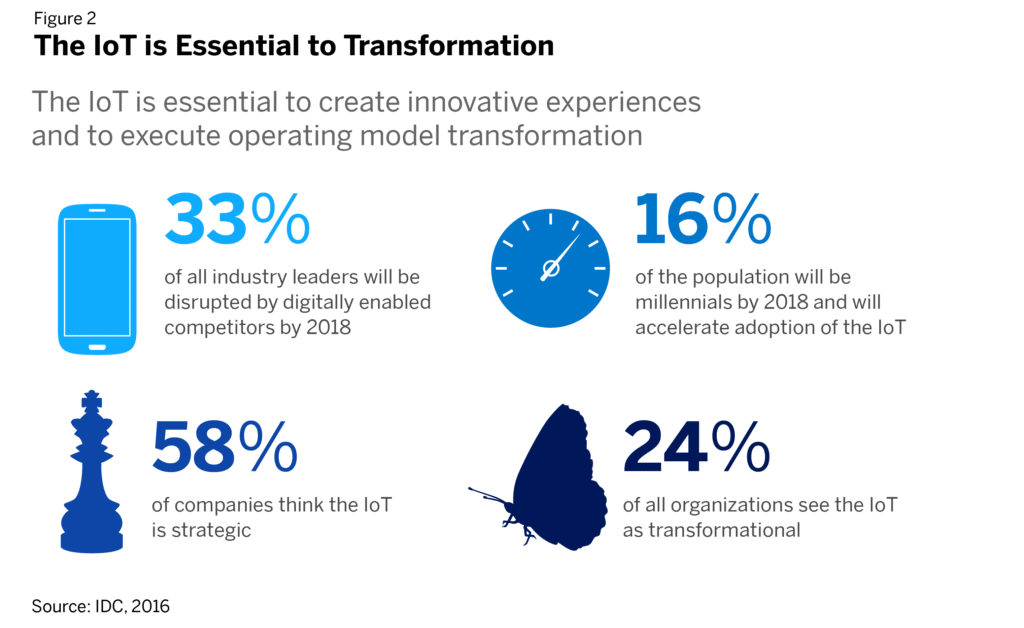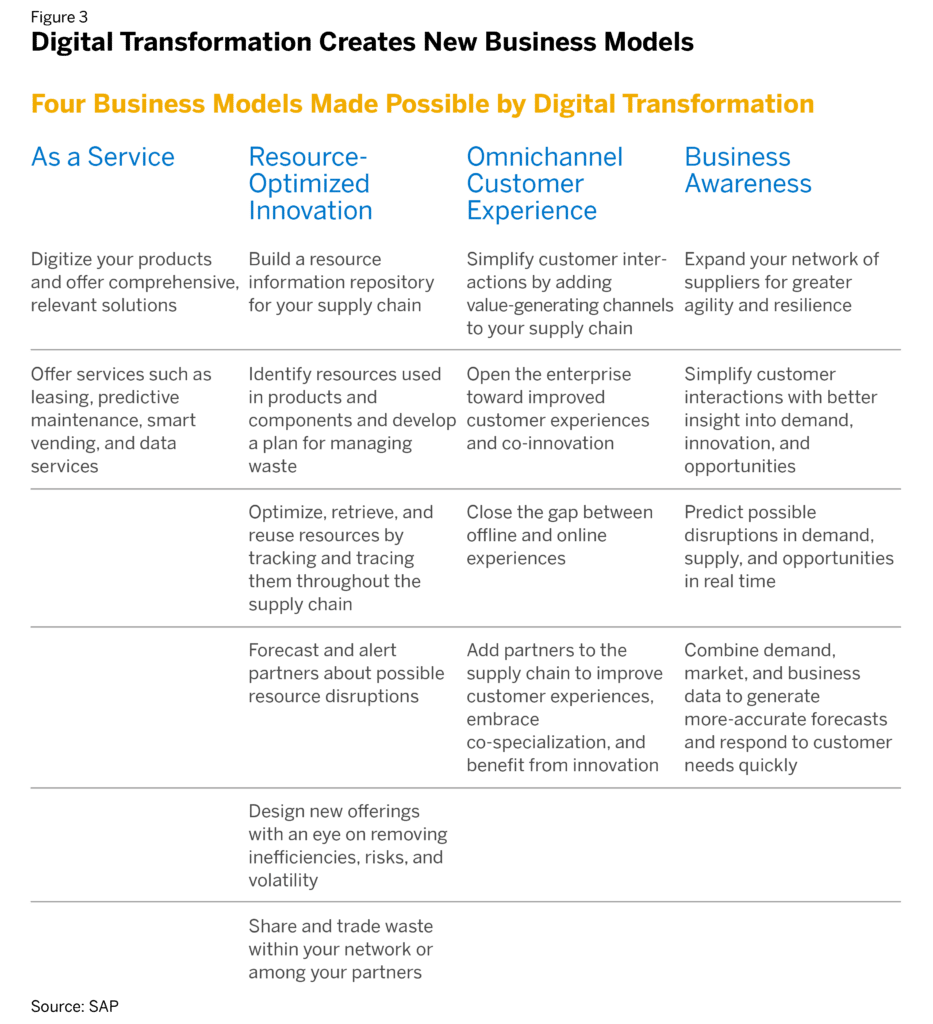your journey
Live Business: The Importance of the Internet of Things
Good article published by Kai Goerlich in Digitalist.
The value of the Internet of Things won’t be in the connections; it will be in the exponential amounts of data generated by those connections and processes.
The Internet of Things (IoT) is not merely a step along the path to digital transformation; it is the driving force.
By 2025, the IoT’s economic impact could reach US$11 trillion, or 11% of global economic value, and by 2030 the IoT could influence nearly the entire economy.
At the core of the IoT are smart devices. They will come in every shape and size, from nanochips and smart dust to gigantic machines. The number of connected things will grow exponentially from 15 billion in 2015 to 200 billion in 2020.
However, while the IoT seems to be just one technology, it actually incorporates other major technologies, such as cloud computing, data analytics, mobile, sensors, and machine-to-machine communications.
The real value of the IoT doesn’t come from all the connections it creates but from the data it generates. With real-time data analytics, the IoT becomes a live communications network for fostering insights and improvements. It will also become the foundation of Live Business, in which companies will be able to sense and respond to customers in the moment.
Sensors Become Ubiquitous
Sensors are the messengers of the IoT, and by 2030 there will 1 trillion of them.3 By putting sensors on everything around us – even inside of us – we will be able to exchange information and participate in a global data network. The IoT will become ubiquitous.
New Interactions Between People, Things, and Machines
Algorithms that control machines are becoming increasingly sophisticated. We already have self-driving cars and self-learning robots. By setting up machine-to-machine communications and creating algorithms that enable things and machines to control each other, we will create a new level of automation that will dramatically change how we interact, work, and collaborate.
We will see many new interactions between people, things, and machines that today seem like science fiction (see Figure 1). Many of the things in our daily lives at home and work will interact with each other, enabling us to use them in new ways. In this connected world, having access to things like cars will become more important than owning them.
At the human-to-machine level, we will be able to gauge the status of machines, receive warnings when they need maintenance, and control their roles in production at any given moment. The IoT will also enable us to control robotic extensions of our bodies, such as replacements for lost or disabled limbs or suits to improve our strength and other capabilities. And humans and machines will work together as teams, communicating through the IoT.
Using the IoT, machines will coordinate and communicate with other machines to create large armies of automated bots capable of acting together in swarms, as ants do in nature. Machines will also be able to monitor one another for potential problems and perform repairs without human intervention.

The Impact of Mobile Shows the IoT’s Potential
While mobile made people a part of the digital revolution, the IoT enables everything else to be part of that transformation. Because the IoT will affect so many different aspects of the economy, its generated value will exceed that of mobile.
Mobile started in 1990 with 2G, got more serious in 2000 with 3G, and finally kick-started the smartphone with 4G in 2010. With each technical leap, mobile’s social and economic impact increased in areas such as healthcare, finance, and education. The Internet may have connected many people in the world, but mobile gave them true global access. Mobile also allowed individuals and small and midsize enterprises to join a global economy that had long been dominated by big companies.
Mobile had a direct economic impact of $3 trillion on a global value chain in 2014, created 11 million jobs in the global value chain, and resulted in billions of R&D investments and startups. This transformation was the result of a huge investment from many players within IT and telecommunications that developed the core technologies, infrastructures, mobile networks, apps, and devices.
While behind mobile, the IoT is following a similar path. It started as a concept around 2000, is now in its second wave of development, and is experiencing exponential growth. Not only are IT and telecommunications companies investing in the IoT; so are players from outside the classical digital markets.
The IoT won’t remain behind mobile, however. It will spark a transformation that will exceed mobile’s by connecting everything together. We expect nothing less than a reinvention of interactions, communications, and services on a global scale, creating new jobs and opportunities.
Five Building Blocks of a Live IoT Strategy
As stated earlier, the IoT’s real value isn’t in the connections but in the data it creates. This massive digitisation allows us to gather data and information and come up with decisions in the moment. When the IoT is integrated into the overall business strategy, a company has the opportunity to become a Live Business – when the entire business focuses on sensing and responding to customers in all the moments that matter most to them. Only companies that embrace the culture of a Live Business will take full advantage of the IoT.
How do you embrace that culture and create a live IoT strategy? Here are five steps to building that strategy.
Connect Priority Assets
Most of a company’s fixed assets aren’t yet interactive through the IoT. As a result, companies have no comprehensive view of the status of assets and their value. By digitising the most important assets through the IoT, companies can significantly increase asset utilisation and longevity by adding predictive maintenance services and measuring and improving their performance and use patterns.
Reinvent Processes
The increasing connection of people, things, and machines will significantly impact today’s business models, most of which were developed in the analog era. Organisations will have to transform themselves digitally or risk disruption and extinction.
Despite the strategic importance of the IoT for many businesses, adoption remains low. There are many reasons, but two stand out. First, the IoT doesn’t come in an easily configurable package; it is part of a business and IT transformation. Second, the IoT will affect business models and customer channels that have been built up over decades, creating a cultural change as big as the transition from punch cards to the PC.
But digitisation will not wait for the faint hearted. IDC estimates that roughly 30% of industry leaders will be disrupted by digitisation. From the examples we know already – the iPod versus the music industry, Uber versus taxis, and Netflix versus classic TV – the IoT is a significant part of digital transformation. It’s no surprise, then, that nearly 60% of companies view the IoT as strategic and another 24% view it as transformational.7 (See Figure 2.) The companies that can transform themselves using the IoT will be able to change their business models and extend them into new markets much faster, remaining one step ahead of their analog rivals. That’s a huge advantage.

Reimagine Work
By creating networks of machines and devices in our physical and virtual workplaces, the IoT will increase productivity. Employees can react in real time to demands, changes, and opportunities. Things and machines will have increased utilisation and longevity. And physically stressful or dangerous work can be handed over to machines, freeing up human workers’ time and energy to focus on quality and creativity.
Enable Operability and Openness
The IoT’s potential can only be fully realised, though, when things, devices, and machines are technically able to interact with each other not just within the boundaries of the company but within a larger business ecosystem. All digitised assets will need a high level of interoperability so they can communicate through modern IoT standards and connect to a company’s business systems.
But the IoT’s real gold is in the data that is collected from all the various things, devices, and machines that are connected together. Companies will need a data strategy for the IoT, using open standards for data exchange.
Develop Live Responsiveness
With billions of connected things expected in the future, we will amass more data than ever. SAP estimates that the IoT will create over 600 zettabytes of data by 2020, and the volume of data exchanged between IoT devices will be 200 times that of the traffic between data centres or end-user devices. Most organisations already find it difficult to extract valuable information from the vast amounts of data that they collect today. While SAP estimates that data analysis speeds will increase roughly 30 times by 2030, companies using IoT nevertheless need a very robust and up-to-date data strategy so they won’t sink in an ocean of meaningless data. IoT-driven real-time data streams need a real-time and in-memory computing infrastructure to glean valuable insight from the data.
How to Go Live with the IoT
Given the huge potential of the IoT as a tool for transformation, it’s difficult for companies to know where to begin. Here are several use cases for getting started.
Strategic Asset Management
Most companies today don’t have a real-time information repository of their assets, yet fixed assets can account for as much as one-third of all operating costs. Even in a highly automated manufacturing process, then, strategic IoT-based asset management can help save costs and resources and define a new path for innovation. With the IoT, businesses can monitor and evaluate asset usage patterns and maintenance routines, estimate current asset values, and find new ways to optimise asset use. Moreover, companies can share their assets with business partners, which will drive down costs and potentially uncover new business models. Companies can manage their assets with the IoT by optimising routing for cars and trucks involved in logistics services, reducing machine downtime through remote maintenance and predictive analytics, and improving logistics and production planning by combining data from the IoT with demand and logistics.
Customer Experience
Digitisation is radically changing the customer experience. By using the IoT as a direct feedback loop throughout the customer journey, businesses can enhance every purchase and interaction experience to transform passive consumers into live interactive partners and co-innovators. The true benefit of the IoT in this case is to offer a personalised and contextualised experience for customers in the moment.
Product and Service Experience
The IoT is enabling businesses to deliver more proactive and interactive products and services, which improves the brand experience and customer loyalty. Moreover, businesses can use the IoT to improve their products and services and co-innovate with customers, while remaining constantly in touch with them to understand their changing needs and wants.
Environmental Scanning
Sensor technology is constantly improving, which will allow more devices and machines to proactively monitor their environments and deliver a live view of the world around us at a much higher resolution. Companies will be able to use sensors to scan the environment to improve navigation, logistics, city planning, weather prediction, agricultural planning, and pollution management, for example. By combining real-time IoT information with existing data, organisations can react faster to change, create new insights, and develop new products and services.
Advanced Cooperation
Many devices and daily things around us will be enabled to interact with humans and with each other, creating a totally new experience in the physical world. We are already exploring connected and interactive cars and various forms of wearables.
Four Business Models for an IoT World
Whether a company decides to address one or all of these use cases, leaders can introduce the company to new ways of running its operations and serving its customers. Through seamless digital transformation, the business can improve and simplify how it senses, predicts, learns, adapts, and responds to changing customer demands and market dynamics.
Not only do these capabilities fine-tune decision making, operations, supply chains, products, and the partner network, they also allow employees of all levels and responsibilities to create and meet customer demand in the moment of opportunity. By embracing new business models, companies can transform themselves into a living and consistently evolving entity.
SAP connects these areas of disruption, which are central to the digital economy. By linking them to a reimagined digital core, every part of your business process is united to create a fluid, nimble, and digital Live Business. For your company, this means a platform for resource optimisation and future business innovation. Here are four models to consider.
As a Service
The move from products to services has been under way for some time, but digitisation will speed up the transition, as the IoT allows companies to more directly serve their customers. The IoT will also help companies meet increasing customer demand for live service. Companies should use the potential offered by the IoT to develop new services along the product lifecycle and look for ways to create services using existing capabilities within the organisation.
Resource-Optimised Innovation
Using the IoT, companies can make their products more interactive. They can monitor the actual use of their products, getting live feedback from customers and gathering data about longevity and performance. Products will no longer be designed once but will go through multiple iterations as part of a continuous, real-time innovation process. Not only will products become better over time, but customer loyalty will also be improved.
Omnichannel Customer Experience
Today’s digital customers demand a seamless shopping experience in all channels. Retailers and consumer-product companies must close any gaps between offline and online experiences. The digital IoT-driven channel will improve the brand experience and create opportunities for co-innovation.
Business Awareness
Today’s businesses are operating in a 24-hour real-time environment. Combined with a live-data analytics strategy, the IoT can be used as an antenna to reveal business changes. By getting faster and better information about demand changes and altered buying behaviour, by predicting potential disruptions, and by identifying opportunities, companies will significantly increase their resilience in the marketplace.

How to Take Advantage of the Second Wave of the IoT
The IoT is entering a second wave that gives companies the opportunity to become live, digital businesses. Looking at ways that the IoT is being used today, from medical devices in a hospital to fan experiences in a football stadium, we can envision a future where technology will be a part of nearly everything we do in business and private life.
For companies, what matters most in a fully connected world is data. Capturing data from many diverse sources and processing it in real-time to create insights will be critical to success.
Share this:

Neil ran his first SAP transformation programme in his early twenties. He spent the next 21 years working both client side and for various consultancies running numerous SAP programmes. After successfully completing over 15 full lifecycles he took a senior leadership/board position and his work moved onto creating the same success for others.